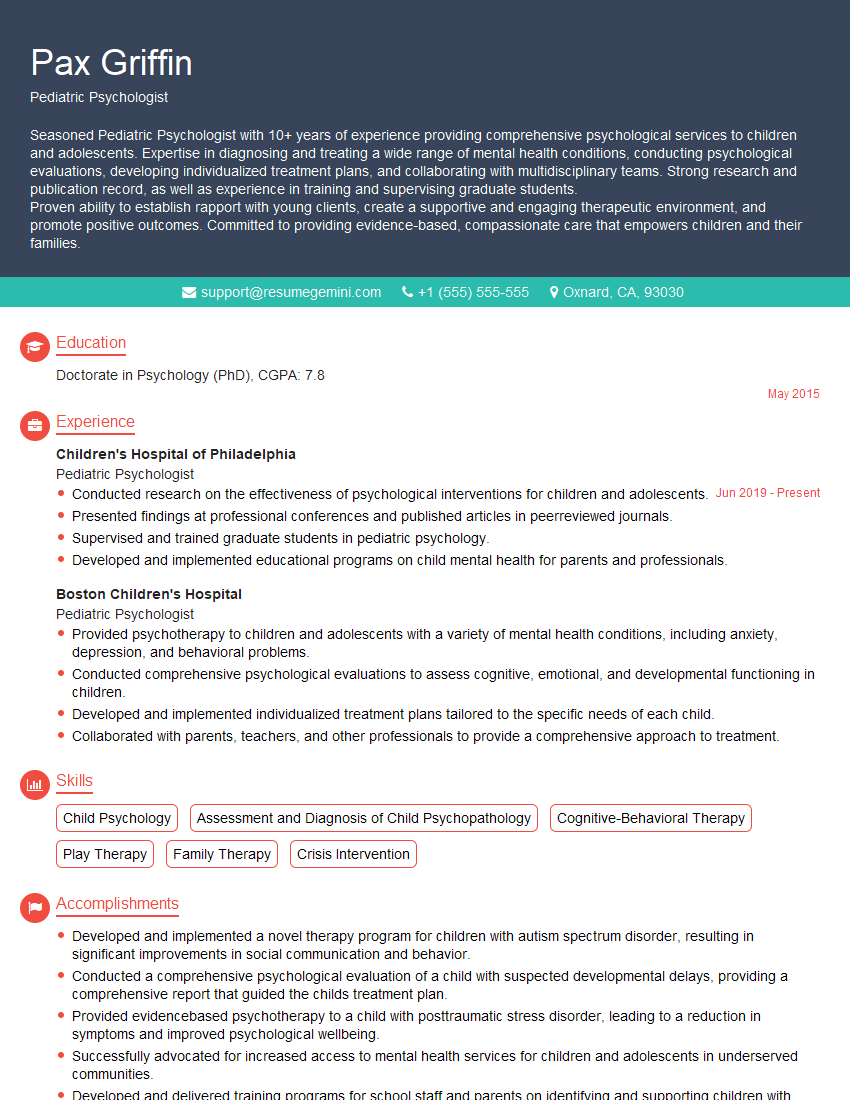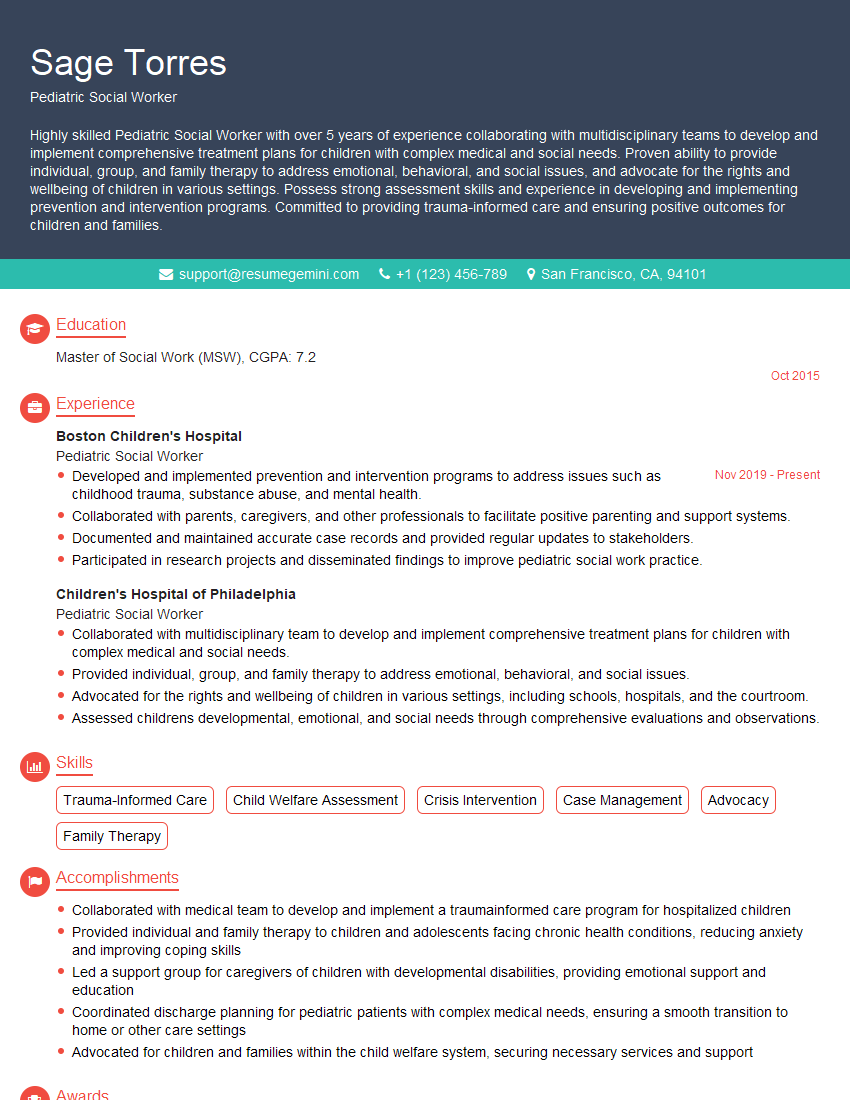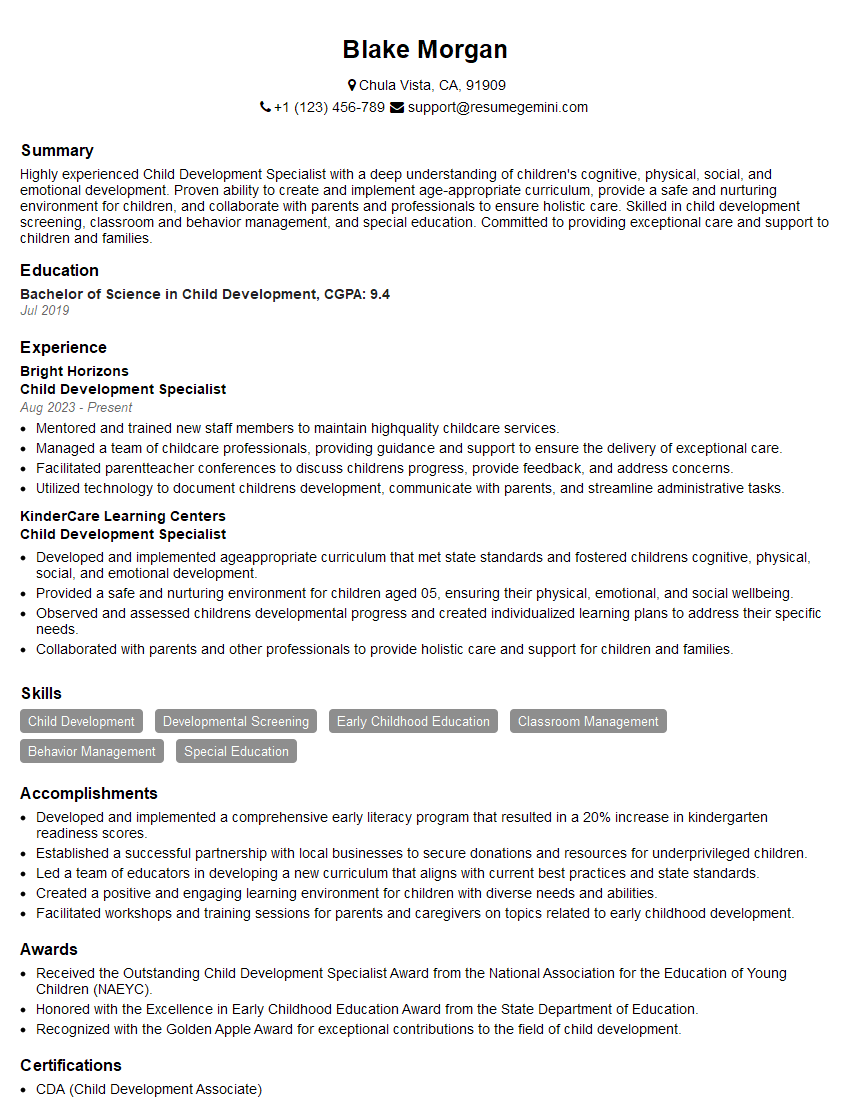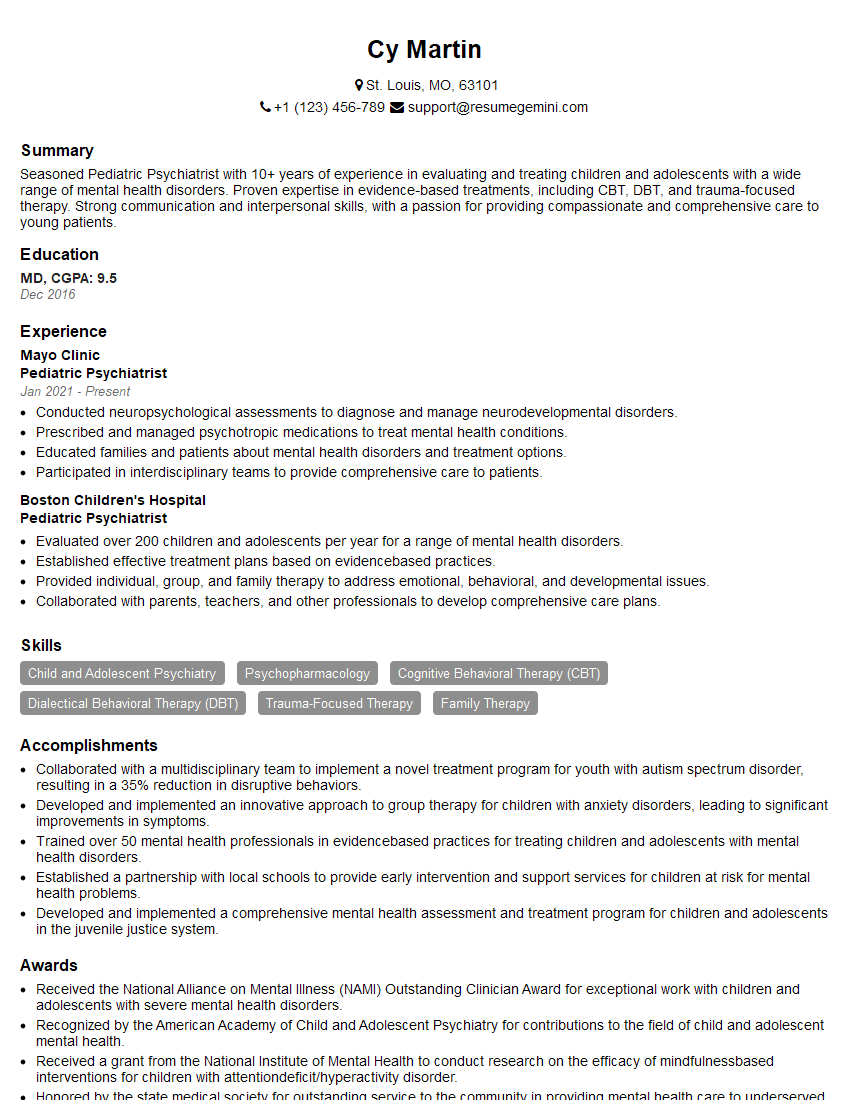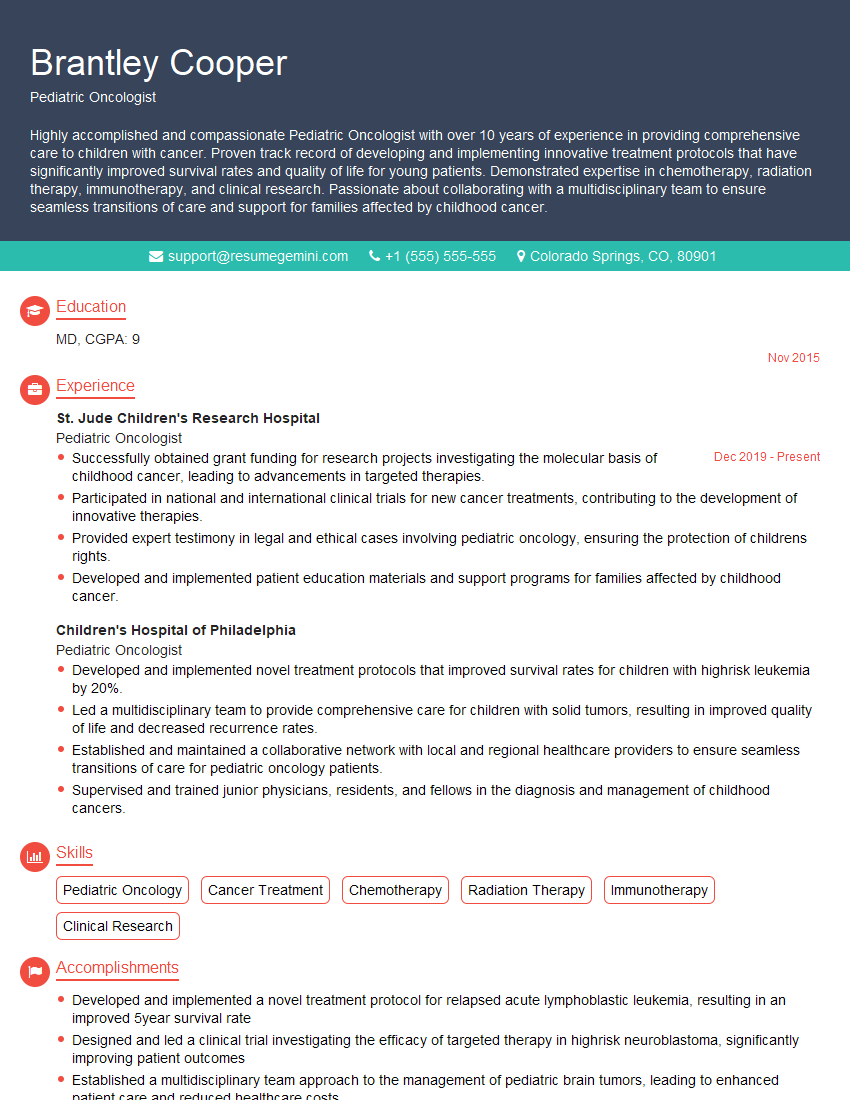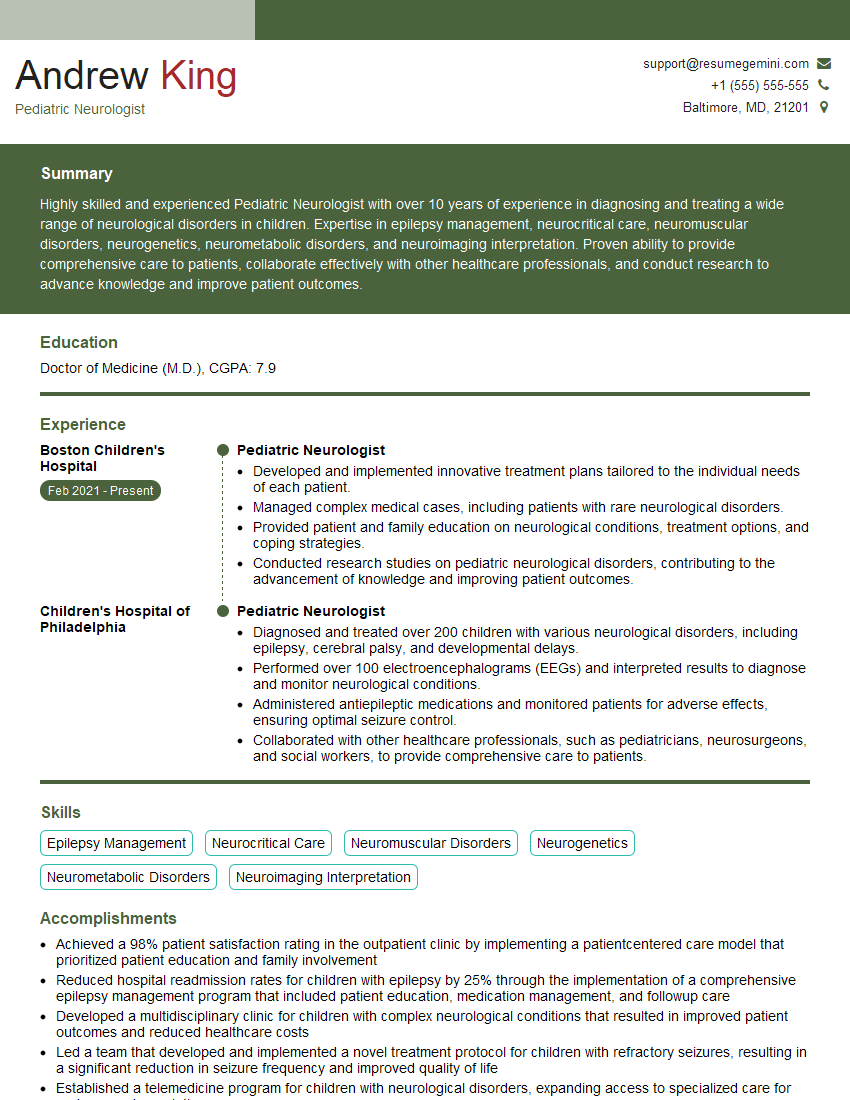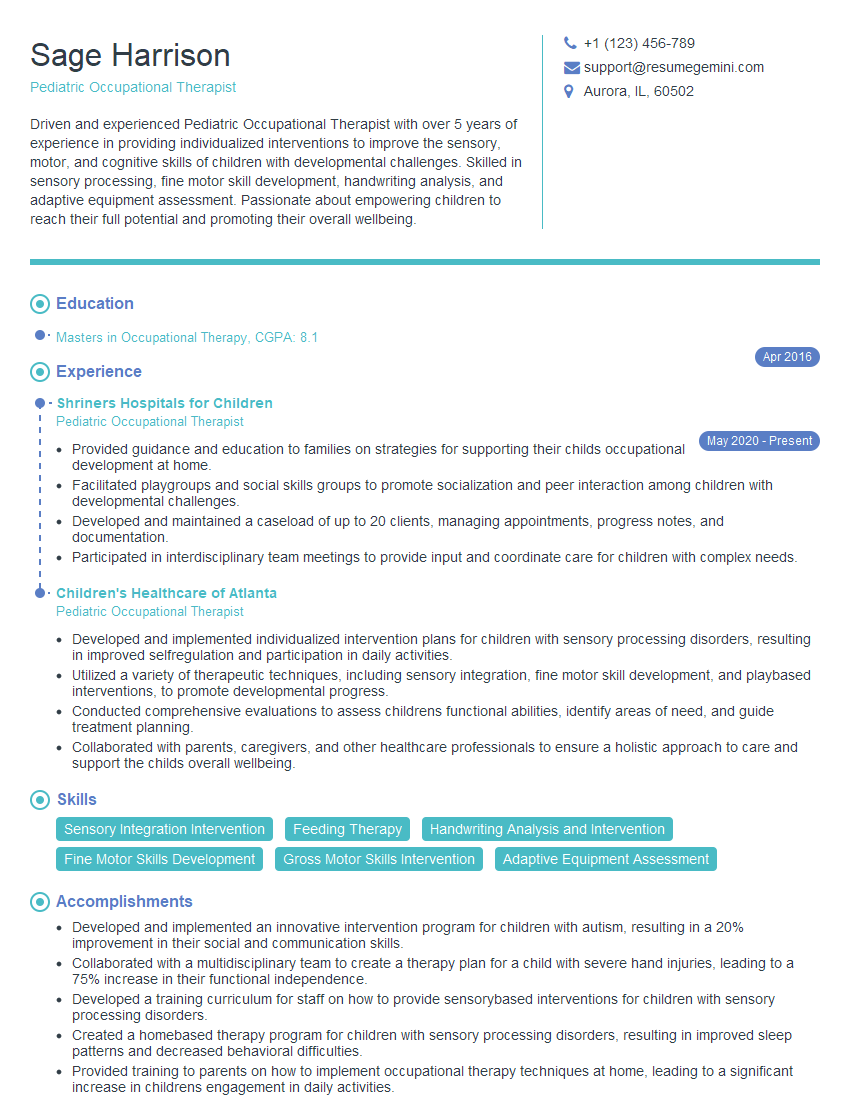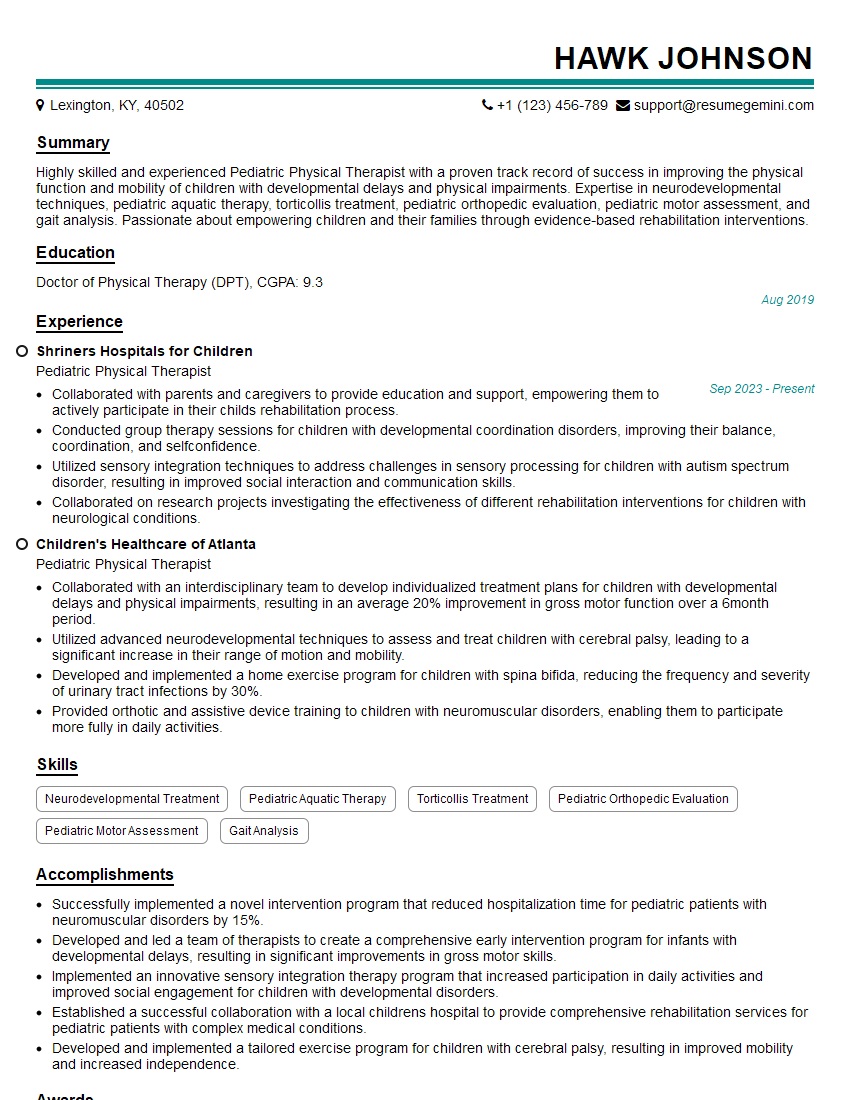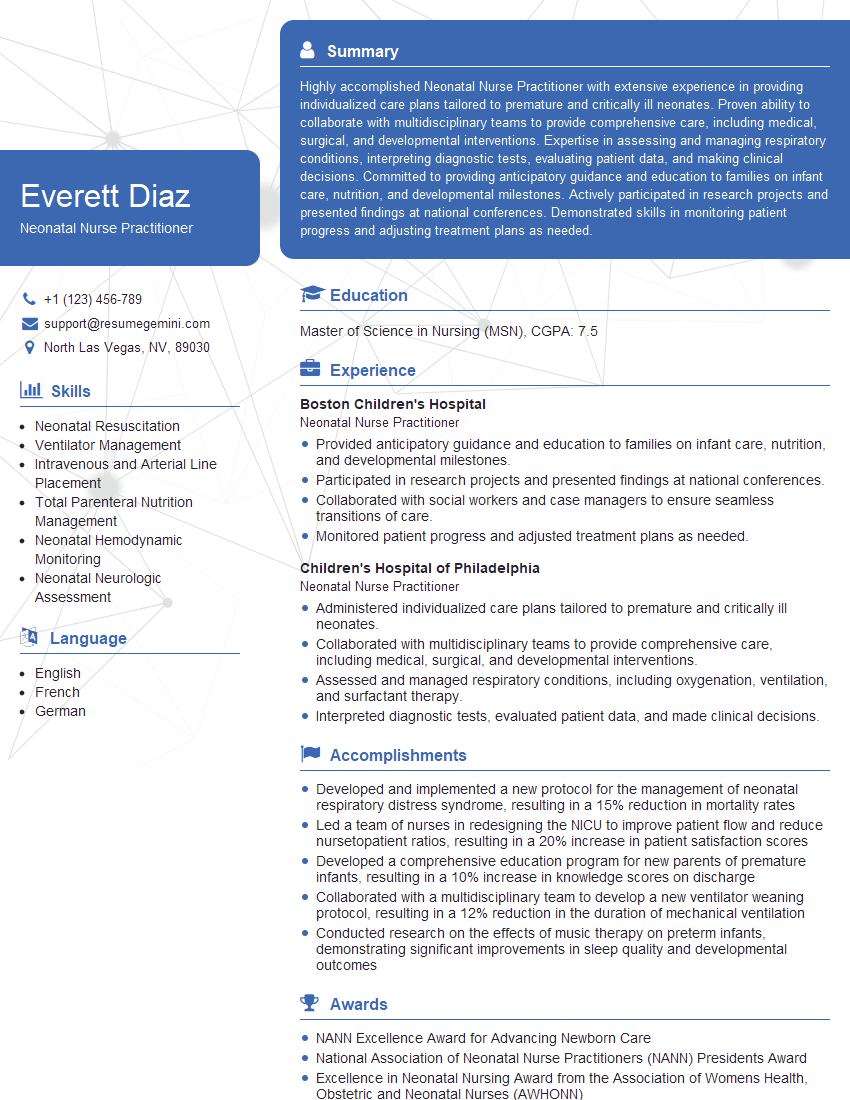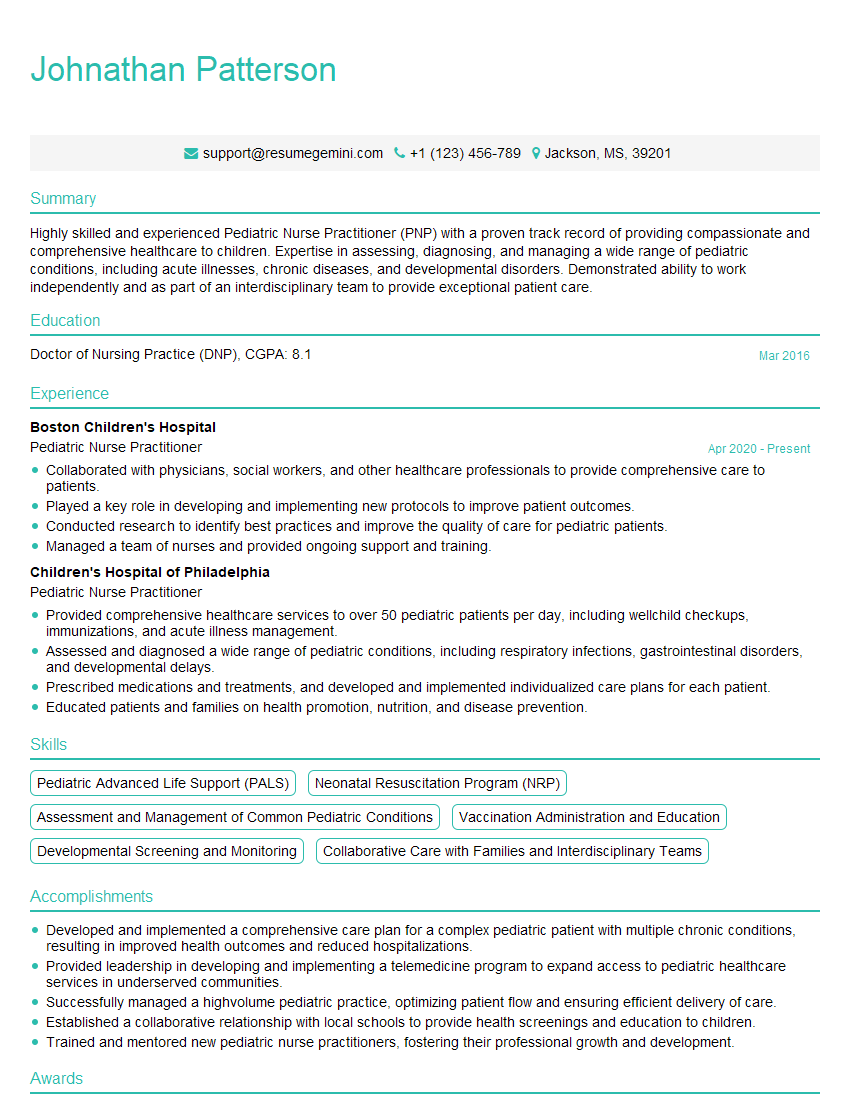Every successful interview starts with knowing what to expect. In this blog, we’ll take you through the top Pediatric Interdisciplinary Team Collaboration interview questions, breaking them down with expert tips to help you deliver impactful answers. Step into your next interview fully prepared and ready to succeed.
Questions Asked in Pediatric Interdisciplinary Team Collaboration Interview
Q 1. Describe your experience facilitating communication within a pediatric interdisciplinary team.
Facilitating communication within a pediatric interdisciplinary team requires a multifaceted approach focusing on clear, consistent, and respectful dialogue. It’s like orchestrating a symphony – each instrument (team member) plays a vital role, and the conductor (me) ensures harmonious collaboration. My experience involves employing various strategies:
Regular Team Meetings: Structured meetings with clear agendas are crucial. These allow for updates on patient progress, identification of challenges, and collaborative problem-solving. I ensure everyone has a chance to contribute.
Utilizing Communication Technology: We utilize secure platforms for electronic health records (EHR) and instant messaging to ensure prompt information dissemination and reduce delays. For example, using a secure messaging system for quick questions and updates minimizes phone tag and ensures confidentiality.
Active Listening and Feedback: I actively listen to each team member’s perspective, valuing their expertise and experience. This includes providing constructive feedback and encouraging open dialogue.
Creating a Culture of Respect: Establishing a safe and inclusive environment where everyone feels comfortable sharing their ideas, concerns, and challenges is paramount. This fosters mutual trust and respect, leading to more effective communication.
Q 2. How do you ensure effective information sharing among team members?
Effective information sharing is the cornerstone of successful interdisciplinary teamwork. Think of it like building a house – each piece of information (brick) is essential to create a strong and stable structure (patient care plan). My strategies include:
Centralized Electronic Health Records (EHR): Utilizing a robust EHR system ensures that all team members have access to the most up-to-date and comprehensive information about the patient. This eliminates information silos and promotes efficient collaboration.
Standardized Reporting: Implementing standardized reporting formats ensures consistent and accurate communication. For instance, we use structured progress notes that highlight key observations and interventions, preventing ambiguity.
Regular Documentation and Updates: Frequent updates in the EHR and timely communication of significant events or changes in the patient’s condition are non-negotiable. This transparency prevents misunderstandings and allows for timely adjustments to the care plan.
Team Huddles/Briefings: Short, focused huddles or briefings at the beginning or end of shifts or rounds allow for efficient sharing of critical information. This minimizes interruptions to direct patient care and maximizes efficiency.
Q 3. Explain your approach to conflict resolution within a pediatric interdisciplinary team.
Conflict resolution within a pediatric interdisciplinary team requires a delicate balance of empathy, assertiveness, and problem-solving. It’s about navigating differences in opinion or approach constructively, remembering that everyone shares the same goal – the best possible outcome for the child. My approach uses a structured, collaborative method:
Identify the Source of Conflict: The first step is to clearly identify the specific issue or disagreement. This might involve open discussion to understand each team member’s perspective.
Facilitate Open Communication: Creating a safe space for each individual to express their concerns and feelings without interruption is vital. Active listening and empathy are critical.
Collaborative Problem-Solving: Once everyone’s perspectives are understood, we work together to find mutually acceptable solutions. Brainstorming and exploring various options are key to finding a compromise.
Document Resolution: Once a solution is agreed upon, it is documented in the EHR for clarity and to ensure consistent follow-through.
Follow Up: Regular follow-ups are crucial to ensure the agreed-upon solution is effective and that any further issues are addressed promptly.
Q 4. Describe a time you had to advocate for a patient’s needs within a multidisciplinary setting.
I once had to advocate for a child with complex medical needs who was struggling with severe feeding difficulties and significant weight loss. The gastroenterologist recommended a specialized feeding tube, but the insurance company initially denied coverage citing insufficient evidence of medical necessity. I worked with the dietitian, nursing staff, and the child’s parents to document the child’s ongoing weight loss, nutritional deficiencies, and the impact on their overall health and development. We compiled detailed data from the EHR, including weight charts, lab results, and parental reports. This comprehensive documentation supported a strong appeal to the insurance company, and we successfully overturned their initial denial, securing the necessary funding for the feeding tube. This ensured the child received the life-sustaining nutrition they needed, showcasing the importance of collaborative advocacy within the team.
Q 5. How do you prioritize patient care within the constraints of an interdisciplinary team?
Prioritizing patient care within an interdisciplinary team requires a structured and collaborative approach. It’s about understanding that various tasks and concerns compete for attention, but the child’s immediate needs and long-term well-being always take precedence. My strategy centers on:
Patient-Centered Care Planning: The care plan itself guides prioritization. We identify the most urgent needs based on the patient’s current condition and potential risks, ensuring that life-threatening or debilitating conditions are addressed first.
Regular Prioritization Meetings: We frequently re-evaluate priorities during regular team meetings. This allows the team to respond to changes in the patient’s condition and adjust the plan accordingly.
Utilizing a Standardized Prioritization System: We employ a system where team members can easily flag the urgency level of different tasks and interventions. This ensures clear communication about priorities and workload distribution.
Clear Communication of Priorities: Open and transparent communication regarding prioritization is key. This keeps everyone on the same page and prevents confusion or conflicts over resource allocation.
Q 6. How do you ensure all team members understand and contribute to the patient’s care plan?
Ensuring everyone understands and contributes to the patient’s care plan is vital for successful interdisciplinary collaboration. It’s like a team working on a jigsaw puzzle – each piece (team member’s expertise) is essential to complete the picture (patient care). My approach is based on:
Collaborative Care Plan Development: Involving all relevant team members in the creation of the care plan from the outset ensures buy-in and understanding. This collaborative process emphasizes shared decision-making and promotes ownership.
Clear and Concise Documentation: The plan is documented in clear and concise terms, avoiding medical jargon whenever possible and using visuals when appropriate. This ensures accessibility and comprehension for all members.
Regular Education and Training: Providing ongoing education and training opportunities keeps the team updated on best practices and any changes in treatment protocols. This ensures everyone is equipped to contribute effectively.
Open Communication Channels: Maintaining open communication channels encourages questions, feedback, and suggestions. Regular meetings and informal communication opportunities are important for clarification and feedback.
Q 7. Describe your experience with developing and implementing a care plan for a complex pediatric case.
I recently worked on a complex case involving a child with cystic fibrosis, diabetes, and severe gastrointestinal issues. Developing and implementing a care plan required a highly coordinated effort from the pulmonologist, endocrinologist, gastroenterologist, registered dietitian, respiratory therapist, and nurses. The process involved:
Comprehensive Assessment: We began with a thorough assessment of the child’s condition, encompassing all aspects of their health and well-being. This included reviewing past medical history, lab results, and conducting detailed physical examinations.
Collaborative Goal Setting: Working collaboratively, we established clear, measurable, achievable, relevant, and time-bound (SMART) goals for the child’s care. This involved addressing both immediate needs (e.g., managing acute respiratory infections) and long-term goals (e.g., improving nutritional status and lung function).
Integrated Care Plan: We developed an integrated care plan that addressed all aspects of the child’s health. This included strategies for managing their cystic fibrosis, diabetes, and gastrointestinal issues, ensuring the interventions were synergistic and avoided conflicting treatments.
Regular Monitoring and Evaluation: We established a system of regular monitoring to track the child’s progress toward the established goals. This involved ongoing communication and collaboration amongst all team members and regular review of the care plan to ensure its efficacy and adapt as needed.
The success of this case demonstrates the importance of a truly interdisciplinary approach, where each team member’s unique expertise contributes to the comprehensive care of a complex patient.
Q 8. Explain your understanding of the roles and responsibilities of different members of a pediatric interdisciplinary team.
A pediatric interdisciplinary team functions like an orchestra, with each member playing a crucial role to create harmonious patient care. The team’s composition varies depending on the child’s needs, but typically includes:
- Pediatrician/Physician: Leads the team, diagnoses and manages medical conditions, orders tests, and prescribes medications.
- Nurse Practitioner/Registered Nurse: Provides direct patient care, administers medications, monitors vital signs, educates families, and collaborates with other team members.
- Physical Therapist (PT): Assesses and treats movement disorders, develops exercise plans, and promotes physical function.
- Occupational Therapist (OT): Addresses fine motor skills, self-care activities, and adaptive equipment needs.
- Speech-Language Pathologist (SLP): Evaluates and treats communication and swallowing difficulties.
- Social Worker: Provides psychosocial support, addresses family needs, connects families with resources, and advocates for the child.
- Child Life Specialist: Uses play and other therapeutic techniques to support children’s emotional and psychological well-being during medical procedures and hospitalizations.
- Dietician/Nutritionist: Develops individualized nutrition plans to meet the child’s specific dietary needs.
- Psychologist: Provides psychological assessments and interventions for emotional and behavioral challenges.
For example, in a case involving a child with cerebral palsy, the team might include a pediatrician, PT, OT, SLP, and social worker, each contributing their expertise to the child’s treatment plan. The pediatrician would manage the medical aspects, the PT would focus on mobility, the OT on daily living skills, the SLP on communication, and the social worker on the family’s support needs.
Q 9. How do you navigate differing opinions or approaches among team members?
Differing opinions are inevitable in interdisciplinary teams, reflecting the diverse perspectives and expertise each member brings. I believe healthy conflict is crucial for optimal care. Navigating these differences involves:
- Respectful Communication: Active listening, empathy, and clear articulation of viewpoints are essential. I strive to create a safe space where everyone feels comfortable expressing their opinions.
- Evidence-Based Decision Making: I encourage team members to support their opinions with evidence-based research and clinical guidelines. This promotes objective evaluation of different approaches.
- Collaborative Problem Solving: Instead of viewing differences as obstacles, I frame them as opportunities for creative solutions. Brainstorming sessions and open discussions are highly valuable.
- Compromise and Negotiation: Reaching a consensus may require compromise. I encourage team members to find common ground while prioritizing the child’s best interests.
- Mediation (if necessary): If disagreements escalate, a neutral mediator can help facilitate constructive dialogue and resolution.
For instance, in a case of a child with autism, a disagreement might arise between the psychologist and the teacher about the best intervention strategy. Through respectful dialogue, evidence-based arguments, and collaborative problem-solving, we could find a plan that incorporates elements from both perspectives, ensuring a holistic and effective approach.
Q 10. Describe your experience using technology to improve communication and collaboration within a pediatric team.
Technology is revolutionizing pediatric interdisciplinary team collaboration. I have extensive experience leveraging various platforms to enhance communication and efficiency:
- Electronic Health Records (EHRs): EHRs allow seamless sharing of patient information, test results, and progress notes among team members, eliminating delays and improving coordination.
Example: Using EPIC or Cerner to share a child's latest lab results with the dietician. - Secure Messaging Platforms: HIPAA-compliant messaging systems (e.g., secure email, dedicated clinical communication platforms) facilitate quick and efficient communication, reducing reliance on phone calls and minimizing the risk of miscommunication.
- Video Conferencing: Video conferencing tools streamline multidisciplinary meetings, especially beneficial when team members are geographically dispersed or when involving families in virtual consultations.
- Telehealth Platforms: Telehealth has become increasingly important, enabling remote monitoring and virtual consultations, enhancing access to care, particularly for children in rural areas.
- Patient Portals: Secure portals allow families to access their child’s medical records, appointments, and communicate directly with team members, fostering better engagement and transparency.
For example, using a secure messaging platform allowed me to quickly share a concerning observation about a patient’s medication side effects with the pharmacist, leading to prompt adjustment of the medication regimen.
Q 11. How do you maintain confidentiality and adhere to HIPAA regulations within a team setting?
Maintaining confidentiality and adhering to HIPAA regulations is paramount in pediatric healthcare. We employ several strategies to protect patient privacy within the team:
- HIPAA Training: All team members receive comprehensive HIPAA training to understand their responsibilities in protecting Protected Health Information (PHI).
- Secure Communication Channels: As mentioned, we use only HIPAA-compliant methods for communication, avoiding personal email or unsecure messaging.
- Restricted Access to Records: Access to patient records is limited to authorized personnel with a legitimate need to know. Access is monitored and logged.
- Data Encryption and Security Measures: Our EHR system and other electronic platforms utilize robust encryption and security protocols to protect data from unauthorized access.
- Physical Security: Physical access to patient charts and files is also strictly controlled.
- Strict adherence to disclosure protocols: We follow strict protocols for disclosing information to third parties and ensure that consent is obtained when appropriate.
For example, if a family wants a referral to a specialist, we ensure we only share necessary PHI with the specialist, and only with the family’s explicit consent. We document all disclosures carefully and securely.
Q 12. How do you measure the effectiveness of your interdisciplinary team’s work?
Measuring the effectiveness of our interdisciplinary team involves a multi-faceted approach:
- Patient Outcomes: We track key indicators such as improvements in physical function, communication skills, behavioral outcomes, and overall health status. These are often measured using standardized assessments and questionnaires.
- Family Satisfaction: We regularly solicit feedback from families through surveys and interviews to gauge their satisfaction with the care provided and the team’s collaborative efforts.
- Team Performance: We utilize process measures such as meeting attendance, timeliness of communication, and adherence to protocols to assess the efficiency and effectiveness of team operations.
- Length of Stay (LOS): In inpatient settings, shorter LOS can indicate efficient and effective care coordination.
- Readmission Rates: Lower readmission rates suggest successful discharge planning and ongoing support.
By regularly reviewing these data points, we can identify areas of strength and areas for improvement, ensuring ongoing optimization of our team’s performance. For example, a significant improvement in a child’s mobility after a course of PT and OT can be a quantifiable measure of our success.
Q 13. Describe your experience with family-centered care within a pediatric interdisciplinary team.
Family-centered care is the cornerstone of our approach. We believe that parents and caregivers are the most important members of the child’s healthcare team. Their knowledge, experiences, and perspectives are invaluable in shaping care plans and achieving optimal outcomes.
- Shared Decision Making: We actively involve families in all aspects of decision-making, ensuring that they feel empowered and informed. This includes explaining treatment options, addressing concerns, and respecting their choices.
- Respectful Communication: We communicate openly and honestly with families, using clear and understandable language, and addressing their emotional needs.
- Collaboration and Partnership: We strive to build strong partnerships with families, fostering trust and mutual respect. We view families as collaborators rather than passive recipients of care.
- Empowerment and Support: We empower families to take an active role in their child’s care, providing education, resources, and ongoing support.
For instance, before deciding on a particular intervention for a child with ADHD, we would thoroughly discuss the options with the parents, considering their preferences, concerns, and the child’s individual needs, involving them in a shared decision-making process.
Q 14. How do you incorporate family input into the care planning process?
Incorporating family input into the care planning process is crucial. We employ several methods:
- Regular Family Meetings: We hold regular meetings with families to discuss the child’s progress, address concerns, and collaboratively develop treatment plans. These meetings involve all relevant team members.
- Open Communication Channels: We maintain open lines of communication with families, encouraging them to contact us with questions or concerns at any time.
- Active Listening: We actively listen to families’ perspectives, validate their feelings, and demonstrate respect for their knowledge of their child.
- Shared Goals: We work collaboratively with families to establish shared goals for the child’s care. These goals guide the development and implementation of the treatment plan.
- Utilizing Family-Reported Outcomes: We often incorporate family-reported outcome measures to assess the effectiveness of interventions from the family’s perspective.
For example, when creating a plan for a child’s transition from the hospital to home, we will involve the family in discussions about home modifications, necessary equipment, and ongoing support services to ensure a smooth and successful transition. We may even ask the family to share their thoughts on specific assistive devices.
Q 15. How do you handle situations where family members disagree with the team’s recommendations?
Disagreements between families and the healthcare team are unfortunately common, but crucial to navigate respectfully and effectively. My approach centers on viewing the family as the experts on their child’s life and experiences. I begin by actively listening to their concerns, validating their feelings, and ensuring they understand the rationale behind our recommendations. This involves explaining the medical evidence and potential risks and benefits in clear, non-technical language.
For instance, if a family is hesitant about a recommended surgery, I would thoroughly explain the procedure, the potential benefits (improved quality of life, reduced pain), and the potential risks (infection, bleeding). I would also address their specific concerns, perhaps focusing on their fear of anesthesia by explaining the anesthesia process in detail and providing reassurance based on the anesthesiologist’s expertise. If the disagreement persists, I would involve other team members, such as a social worker or child life specialist, to offer support and facilitate open communication. In some cases, a second opinion might be offered to further address concerns. Ultimately, the goal is to reach a shared decision-making plan that aligns with both the family’s values and the child’s best medical interests. The focus is on partnership, not imposition.
Career Expert Tips:
- Ace those interviews! Prepare effectively by reviewing the Top 50 Most Common Interview Questions on ResumeGemini.
- Navigate your job search with confidence! Explore a wide range of Career Tips on ResumeGemini. Learn about common challenges and recommendations to overcome them.
- Craft the perfect resume! Master the Art of Resume Writing with ResumeGemini’s guide. Showcase your unique qualifications and achievements effectively.
- Don’t miss out on holiday savings! Build your dream resume with ResumeGemini’s ATS optimized templates.
Q 16. Describe your experience working with diverse populations within a pediatric team setting.
My experience working with diverse populations in pediatrics has been incredibly enriching. It underscores the importance of cultural humility and sensitivity. I’ve worked with families from a wide range of cultural, socioeconomic, and linguistic backgrounds, each with unique beliefs and practices surrounding healthcare. Understanding these differences is fundamental. This involves learning about various cultural perspectives on health and illness, family structures, communication styles, and decision-making processes.
For example, I worked with a family from a culture where direct confrontation is considered disrespectful. Therefore, I adapted my communication to be more indirect and collaborative. Instead of directly stating my recommendations, I presented them as options and collaboratively worked towards a solution that respected their preferences. Additionally, I made sure to use interpreters when needed and incorporate culturally sensitive practices into our care plan, for example ensuring religious or dietary needs were met. This requires continuous learning and reflection to ensure culturally competent care for every child and family.
Q 17. How do you adapt your communication style to effectively work with different team members and families?
Adapting communication styles is essential for successful interdisciplinary collaboration and family engagement. I employ a flexible, person-centered approach. With team members, I might use direct, concise communication during rounds, while during family meetings, I focus on active listening, empathy, and clear, non-technical explanations.
For example, when communicating with physicians, I use precise medical terminology, but with families, I explain diagnoses and treatment plans using simple language and visual aids where appropriate. With younger children, I use playful language and games to build rapport and decrease anxiety. I also recognize that nonverbal cues are crucial. Maintaining eye contact, using a gentle tone, and showing genuine empathy can significantly improve communication and foster trust. Regular reflection on my communication style and seeking feedback from team members and families helps ensure I continually improve my approach.
Q 18. Explain your understanding of evidence-based practice and its role in pediatric care.
Evidence-based practice (EBP) is the cornerstone of high-quality pediatric care. It involves integrating the best available research evidence with clinical expertise and patient values and preferences to make informed decisions. This ensures that our interventions are effective, safe, and aligned with the most current scientific knowledge.
For instance, when deciding on a treatment plan for a child with asthma, we would consult research studies on the effectiveness of different medications and therapies. We would then consider the child’s specific characteristics (age, severity of asthma, allergies) and the family’s preferences to create an individualized plan. This integrated approach ensures that we’re not just following outdated practices, but delivering the best possible care informed by scientific evidence. EBP is a dynamic process; as new research emerges, we adapt our practices accordingly.
Q 19. How do you stay up-to-date on the latest research and best practices in pediatric care?
Staying current in pediatric care requires a multifaceted approach. I regularly review peer-reviewed journals, such as Pediatrics and The Journal of Pediatrics, to keep abreast of the latest research findings. I actively participate in professional development activities, such as attending conferences and workshops, to learn about new techniques and best practices.
Furthermore, I leverage online resources such as reputable medical websites and professional organizations (e.g., the American Academy of Pediatrics) to access the most up-to-date guidelines and clinical practice recommendations. Engaging in collaborative discussions with colleagues during team meetings and case conferences allows me to benefit from their expertise and insights. Continuous learning is a commitment in this rapidly evolving field.
Q 20. Describe your experience with quality improvement initiatives within a pediatric setting.
My experience with quality improvement (QI) initiatives focuses on enhancing patient outcomes and improving the efficiency of our team’s processes. I’ve been involved in projects aimed at reducing hospital-acquired infections in the pediatric unit. This involved implementing a multi-pronged approach, including implementing strict hand hygiene protocols, enhancing environmental cleaning practices, and providing education to healthcare professionals.
Another project involved streamlining the discharge process to improve patient satisfaction and reduce delays. This was accomplished by analyzing current processes, identifying bottlenecks, and developing a more efficient workflow. The use of data analysis and the Plan-Do-Study-Act (PDSA) cycle were crucial in guiding the QI work and measuring the effectiveness of the interventions. My role often includes contributing to data collection, analysis, and implementation of changes, as well as engaging with interdisciplinary teams to drive system-wide improvements.
Q 21. How do you identify and address systemic barriers to effective pediatric team collaboration?
Systemic barriers to effective pediatric team collaboration can significantly impact patient care. These barriers can be organizational, communication-related, or resource-based. Identifying these barriers is a crucial first step. This requires careful observation, data collection, and feedback from team members and families. For example, inadequate staffing levels can lead to burnout and hinder effective communication. Lack of access to necessary technologies or information systems can impede information sharing.
Addressing these barriers requires a multi-pronged approach. If insufficient staffing is an issue, advocating for increased resources is essential. If communication is a problem, implementing new communication strategies (e.g., standardized communication tools, regular team meetings) can be beneficial. Addressing resource constraints might involve securing grants or collaborating with other departments. Ultimately, creating a culture of open communication, mutual respect, and shared decision-making is key to overcoming these barriers. Openly discussing challenges, implementing solutions, and continually evaluating their effectiveness is a continuous process that involves all stakeholders.
Q 22. Describe a time you had to deal with a difficult or challenging situation within a pediatric interdisciplinary team.
One challenging situation involved a 10-year-old girl with cystic fibrosis who was experiencing a severe exacerbation. The pulmonologist wanted aggressive antibiotic therapy, while the nutritionist stressed the importance of maintaining her already compromised nutritional status, which aggressive treatment might further jeopardize. The family, deeply religious, also had strong reservations about certain medications. This created a conflict between medical necessity, nutritional needs, and family values.
To resolve this, we employed a collaborative problem-solving approach. We held a multidisciplinary meeting, involving the patient’s parents, the pulmonologist, the nutritionist, the social worker, and myself as the primary care physician. We actively listened to each stakeholder’s concerns and prioritized transparent communication. We weighed the risks and benefits of different treatment options, discussing them in a way that the family could understand. Eventually, we reached a compromise involving a modified antibiotic regimen alongside nutritional support strategies tailored to minimize side effects. Regular monitoring and adjustments to the treatment plan allowed us to manage the exacerbation effectively while respecting the family’s values and mitigating the nutritional risks.
This experience highlighted the importance of shared decision-making within the pediatric interdisciplinary team, emphasizing the necessity of considering the emotional and spiritual well-being of the child and their family, alongside the purely medical aspects.
Q 23. How do you manage your time effectively when working with multiple team members and patients?
Effective time management in a pediatric interdisciplinary team setting requires a structured approach. I utilize several key strategies, including detailed scheduling with time blocks allocated for specific tasks and team meetings. Prioritization is crucial; I use a system that ranks tasks by urgency and importance, ensuring that time-sensitive issues receive immediate attention.
I also rely heavily on electronic health records (EHRs) and communication platforms. EHRs provide centralized access to patient information, eliminating redundant searches and saving valuable time. Utilizing secure messaging systems for team communication allows for quick, asynchronous updates and avoids lengthy phone calls. Delegation is another important skill; I identify team members with the appropriate expertise and assign tasks accordingly. Finally, regular review and adjustment of my schedule are essential to accommodate unexpected events and ensure optimal productivity.
Q 24. How do you handle unexpected events or emergencies within a team setting?
Unexpected events, such as cardiac arrests or severe allergic reactions, require immediate and coordinated action. Our team has established well-defined protocols for managing emergencies. Upon encountering an emergency, the team leader (usually the most senior physician present) immediately initiates the established protocol, assigning roles and responsibilities to team members based on their expertise.
Clear and concise communication is paramount. We utilize standardized terminology and reporting structures to ensure everyone understands the situation and their roles. Post-emergency debriefings are crucial for analyzing the response, identifying areas for improvement, and reinforcing team cohesion. We document everything thoroughly in the patient’s chart, ensuring that the incident and the response are clearly recorded for future reference and potential quality improvement initiatives. Regular drills and simulations help us prepare for and refine our responses to unexpected situations.
Q 25. How do you contribute to creating a positive and supportive team environment?
Building a positive and supportive team environment requires fostering open communication, mutual respect, and a shared vision. I actively encourage team members to express their opinions and concerns without fear of judgment. Regular team meetings provide a platform for open discussion and collaborative problem-solving.
I also make a conscious effort to recognize and celebrate individual and team accomplishments. Acknowledging hard work and dedication fosters a sense of appreciation and encourages continued high performance. Furthermore, I prioritize conflict resolution by addressing disagreements constructively and fairly, ensuring that all voices are heard and valued. Creating a culture of psychological safety is essential – a space where team members feel comfortable expressing concerns or admitting mistakes without fear of retribution. Team-building activities, both professional and social, contribute to strengthening interpersonal relationships and fostering a sense of camaraderie.
Q 26. Describe your experience with mentoring or training new team members.
I have extensive experience mentoring and training new team members. My approach involves a structured combination of shadowing, didactic teaching, and hands-on experience. New team members initially shadow experienced colleagues to observe clinical practices and workflows.
Formal training sessions cover relevant protocols, guidelines, and procedures. I provide regular feedback throughout the training period, using both constructive criticism and positive reinforcement to facilitate learning and development. We utilize case studies and simulations to allow new members to apply theoretical knowledge in a safe and controlled environment. I encourage active participation in team meetings to foster collaboration and communication skills. Mentorship extends beyond the formal training period; I remain available for ongoing support and guidance, ensuring a smooth transition into independent practice. This continuous support is crucial to fostering confidence and building competence within the team.
Q 27. How do you ensure that cultural considerations are integrated into patient care plans?
Integrating cultural considerations into patient care plans is essential for providing equitable and effective care. This starts with actively eliciting information about the family’s cultural background, beliefs, and practices during the initial assessment. This may involve using interpreters if necessary and utilizing culturally sensitive questionnaires.
We then incorporate this understanding into the development of the care plan. For example, dietary preferences, religious beliefs that may impact treatment options, and communication styles are all carefully considered. We strive to involve family members and community leaders as needed to ensure the plan aligns with the family’s values and beliefs. We also ensure that our communication is culturally sensitive and avoids any language or practices that may be offensive or inappropriate. Regular reflection and adjustments to the care plan based on ongoing interaction with the family are crucial to ensure we are providing culturally congruent care.
Q 28. How do you use data to inform decision-making within a pediatric interdisciplinary team?
Data plays a crucial role in informing decision-making within our pediatric interdisciplinary team. We utilize various data sources, including patient medical records, clinical outcomes data, and population-based health statistics.
We use this data to track key performance indicators (KPIs), such as infection rates, length of stay, and patient satisfaction. This data allows us to identify trends, assess the effectiveness of interventions, and make data-driven adjustments to our protocols and care pathways. Regular data analysis sessions, facilitated by a dedicated data analyst or team member with data analysis skills, help us understand patterns and make informed decisions regarding resource allocation and process improvements. This evidence-based approach allows us to continuously improve the quality of care we provide and enhance the overall efficiency of the team.
Key Topics to Learn for Pediatric Interdisciplinary Team Collaboration Interview
- Communication & Interpersonal Skills: Effective communication strategies within a multidisciplinary team; active listening, conflict resolution, and assertive communication techniques in pediatric settings.
- Roles & Responsibilities: Understanding the roles and responsibilities of key team members (physicians, nurses, therapists, social workers, etc.) and how they contribute to patient care. Practical application: Describing your experience coordinating care across different disciplines.
- Patient-Centered Care: Applying a patient-centered approach to decision-making within the team; prioritizing the child and family’s needs and preferences. Practical application: Giving examples of how you’ve advocated for a patient’s best interests within a team setting.
- Ethical Considerations: Navigating ethical dilemmas common in pediatric care, such as informed consent, confidentiality, and end-of-life care; understanding the legal and ethical frameworks governing pediatric care.
- Team Dynamics & Leadership: Understanding team dynamics and effective leadership approaches within an interdisciplinary team; fostering collaboration, resolving conflict, and motivating team members. Practical application: Describing a time you led or contributed significantly to a team project in a pediatric setting.
- Case Management & Coordination: Developing and implementing effective care plans in collaboration with the team; coordinating services and resources to optimize patient outcomes. Practical application: Detailing your experience in managing complex pediatric cases.
- Documentation & Record Keeping: Maintaining accurate and comprehensive documentation of patient care within the interdisciplinary team; adhering to relevant legal and regulatory standards.
- Technology & Data Management: Utilizing electronic health records (EHRs) and other technologies to facilitate communication and collaboration within the interdisciplinary team.
Next Steps
Mastering Pediatric Interdisciplinary Team Collaboration is crucial for career advancement in today’s healthcare landscape. It demonstrates your ability to work effectively in a team, contribute to high-quality patient care, and adapt to the complex demands of a pediatric setting. To significantly increase your job prospects, creating an ATS-friendly resume is paramount. ResumeGemini offers a trusted platform to build a professional and impactful resume, ensuring your qualifications shine. Examples of resumes tailored specifically to Pediatric Interdisciplinary Team Collaboration are available to help you build your best application.
Explore more articles
Users Rating of Our Blogs
Share Your Experience
We value your feedback! Please rate our content and share your thoughts (optional).
What Readers Say About Our Blog
This was kind of a unique content I found around the specialized skills. Very helpful questions and good detailed answers.
Very Helpful blog, thank you Interviewgemini team.
